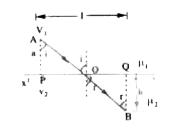The critical angle for light going from medium X into medium Y is θ . The speed of light in medium X is v. The speed of light in medium Y is
vcosθ
vsinθ
vsinθ
vcosθ
The correct Answer is:C
To solve the problem, we need to find the speed of light in medium Y (denoted as v′) given the critical angle θ for light transitioning from medium X to medium Y, and the speed of light in medium X (denoted as v).
1. Understanding Critical Angle:
The critical angle θ is defined as the angle of incidence in medium X at which the angle of refraction in medium Y is 90 degrees. This means that at this angle, light travels along the boundary between the two media.
2. Applying Snell's Law:
According to Snell's Law, we have:
μ1sin(θ)=μ2sin(90∘)
Here, μ1 is the refractive index of medium X, μ2 is the refractive index of medium Y, and sin(90∘)=1.
3. Refractive Index Definition:
The refractive index μ is defined as:
μ=cv
where c is the speed of light in vacuum and v is the speed of light in the medium.
4. Expressing Refractive Indices:
For medium X:
μ1=cv
For medium Y:
μ2=cv′
5. Substituting Refractive Indices into Snell's Law:
Substituting these expressions into Snell's Law gives:
cvsin(θ)=cv′⋅1
6. Canceling c:
Since c appears on both sides of the equation, we can cancel it out:
sin(θ)v=1v′
7. Rearranging to Find v′:
Rearranging the equation to solve for v′:
v′=vsin(θ)
8. Conclusion:
Thus, the speed of light in medium Y is:
v′=vsin(θ)
Final Answer:
The speed of light in medium Y is vsin(θ).
The critical angle θ is defined as the angle of incidence in medium X at which the angle of refraction in medium Y is 90 degrees. This means that at this angle, light travels along the boundary between the two media.
According to Snell's Law, we have:
μ1sin(θ)=μ2sin(90∘)
Here, μ1 is the refractive index of medium X, μ2 is the refractive index of medium Y, and sin(90∘)=1.
The refractive index μ is defined as:
μ=cv
where c is the speed of light in vacuum and v is the speed of light in the medium.
For medium X:
μ1=cv
For medium Y:
μ2=cv′
Substituting these expressions into Snell's Law gives:
cvsin(θ)=cv′⋅1
Since c appears on both sides of the equation, we can cancel it out:
sin(θ)v=1v′
Rearranging the equation to solve for v′:
v′=vsin(θ)
Thus, the speed of light in medium Y is:
v′=vsin(θ)
The speed of light in medium Y is vsin(θ).
Topper's Solved these Questions
- RAY OPTICS AND OPTICAL INSTRUMENTSBOOK - AAKASH INSTITUTE ENGLISHCHAPTER - RAY OPTICS AND OPTICAL INSTRUMENTSEXERCISE - ASSIGNMENT (SECTION - D)
16 Videos
- RAY OPTICS AND OPTICAL INSTRUMENTSBOOK - AAKASH INSTITUTE ENGLISHCHAPTER - RAY OPTICS AND OPTICAL INSTRUMENTSEXERCISE - ASSIGNMENT (SECTION - B)
35 Videos
- PHYSICAL WORLDBOOK - AAKASH INSTITUTE ENGLISHCHAPTER - PHYSICAL WORLDEXERCISE - ASSIGNMENT (Section-B)
4 Videos
- SEMICONDUCTOR ELECTRONICS (MATERIAL, DEVICES AND SIMPLE CIRUITS )BOOK - AAKASH INSTITUTE ENGLISHCHAPTER - SEMICONDUCTOR ELECTRONICS (MATERIAL, DEVICES AND SIMPLE CIRUITS )EXERCISE - Assignment SECTION - D (Assertion & reason type Question)
10 Videos
Similar Questions
Knowledge Check
Critical angle for light going from medium (i) to (ii) is θ . The speed of light in medium (i) is v then speed in medium (ii) is
Av(1−cosθ)BvsinθCvcosθDv(1−sinθ)
The speed of light in an isotropic medium depends on
View SolutionWhen light is refracted into a medium
View SolutionWhen light is refracted into a medium
View SolutionThe dispersion of light in a medium implies that :
View SolutionIf critical angle for TIR from medium to vacuum is 45 deg then velocity of light in medium
View SolutionThe time required for the light to go from A to B, when a ray of lilght goes from point A in a medium where the speed of light is v1 to a point B in a medium where the speed of light is v2 as shown in figure is

View SolutionIf the critical angle for total internal reflection, from a medium to vacuum is 30∘, then velocity of light in the medium is
View Solution
